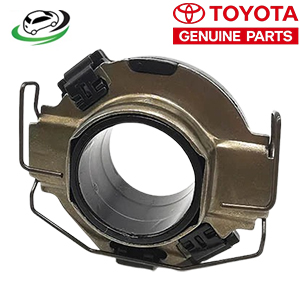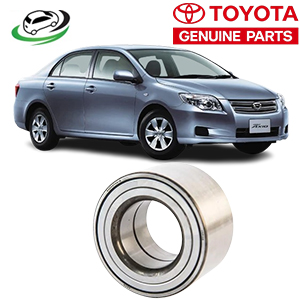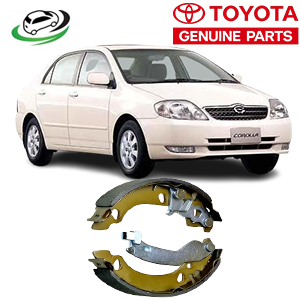-8%
Get Toyota Corolla NZE121 Rear Brake Lining Shoe Kit 04495-52040
The rear brake lining shoe kit is a crucial component in vehicles that utilize drum brake systems, typically found in the rear wheels of many cars, trucks, and SUVs. Though many modern vehicles now use disc brakes in all four wheels, drum brakes still play a vital role in automotive safety, especially in budget vehicles and commercial trucks. The rear brake shoe kit ensures reliable braking performance, and understanding its function, materials, maintenance, and replacement process is essential for both vehicle owners and auto mechanics.
In this comprehensive guide, we’ll explore the design and operation of rear brake lining shoes, the advantages of drum brakes, the materials used in their construction, the common signs of wear, and tips for maintaining and replacing these components.
1. Understanding Rear Brake Lining Shoes and Their Function
In a drum brake system, the brake shoe is the part that presses against the inside of the brake drum to create friction, slowing down or stopping the vehicle. Unlike disc brakes, which use brake pads that clamp onto a rotor, drum brakes have a cylindrical drum that rotates with the wheel. When the brake pedal is pressed, the brake shoe is pushed outward against the rotating drum, generating the friction needed to slow down or stop the vehicle.
- Brake Drum: The drum is the rotating component that is attached to the wheel. It surrounds the brake shoes and provides a surface for the shoes to press against.
- Brake Shoes: Brake shoes are curved, crescent-shaped components lined with friction material. When the brake is applied, the shoes press outward against the inside of the drum to generate the necessary friction to decelerate the vehicle.
- Brake Lining: The brake lining is the friction material that is bonded to the outer surface of the brake shoe. This material is specifically designed to withstand high temperatures and provide consistent friction under different driving conditions.
- Wheel Cylinder: The hydraulic wheel cylinder applies pressure to the brake shoes, pushing them outward against the drum when the brake pedal is pressed. This hydraulic action ensures that braking force is distributed evenly.
The combination of these components ensures that the vehicle’s rear wheels slow down effectively, making the brake shoe a critical part of the overall braking system.
2. Advantages of Drum Brake Systems
Drum brake systems have been widely used in the automotive industry for many decades. While disc brakes have become the norm for front wheels due to their superior stopping power and heat dissipation, drum brakes still offer several advantages, especially when used on rear wheels.
- Cost-Effectiveness: Drum brakes are generally less expensive to manufacture and maintain compared to disc brakes. This makes them an attractive option for budget vehicles and for the rear axles of vehicles that do not require the same level of braking power as the front.
- Self-Energizing Effect: Drum brakes benefit from a self-energizing effect, where the friction generated by the brake shoes pressing against the drum amplifies the braking force. This makes drum brakes very efficient at lower speeds and for heavy vehicles.
- Durability: Rear drum brakes tend to last longer than disc brakes because the rear brakes typically handle less braking force. As a result, the wear rate is slower, and the system is more durable over time.
- Integrated Parking Brake: Drum brakes can incorporate a parking brake mechanism without the need for additional components. The design of the drum brake allows it to lock the rear wheels when the parking brake is engaged, making it simpler and more compact than integrating a parking brake with a disc brake system.
3. Materials Used in Rear Brake Lining Shoes
The materials used in brake shoes and their linings are critical to the performance and longevity of the braking system. Historically, brake linings were made from asbestos due to its excellent heat resistance and durability. However, due to health risks associated with asbestos, modern brake linings are made from safer alternatives, including:
- Organic Materials: Organic brake linings are made from a mix of fibers such as glass, rubber, carbon, and Kevlar. These materials are bonded together with resins to create a durable friction material. Organic linings offer good braking performance, are relatively quiet, and produce minimal dust. However, they tend to wear out faster than other types of brake linings.
- Semi-Metallic Materials: Semi-metallic brake linings are made from a combination of metal fibers (such as steel or copper) and organic materials. These linings are highly durable, provide excellent heat dissipation, and offer superior stopping power. However, they tend to be noisier and produce more brake dust compared to organic linings.
- Ceramic Materials: Ceramic brake linings are made from a mixture of ceramic fibers and filler materials. They are known for being quiet, producing less dust, and lasting longer than organic or semi-metallic linings. Ceramic linings are generally more expensive and are often used in high-performance or luxury vehicles.
The choice of material in a rear brake shoe kit will depend on the specific performance requirements of the vehicle, as well as the owner’s preference for noise, dust, and durability.
4. Common Issues and Symptoms of Worn Brake Lining Shoes
Like all brake components, brake shoes wear down over time and must be replaced to maintain proper braking performance. It’s important to recognize the signs of worn or damaged brake shoes to prevent accidents and ensure the vehicle’s safety. Here are some common symptoms of worn rear brake shoes:
- Reduced Braking Power: If the vehicle’s stopping distance increases or the brakes feel less responsive, it may indicate that the brake shoes are worn and not generating sufficient friction against the drum.
- Noise from the Rear Brakes: A squeaking or grinding noise coming from the rear wheels when braking is often a sign that the brake shoes are worn down and need to be replaced. The noise may be caused by metal-to-metal contact between the worn shoe and the drum.
- Parking Brake Issues: Since drum brakes often integrate the parking brake mechanism, worn brake shoes can affect the functionality of the parking brake. If the parking brake feels loose or doesn’t hold the vehicle in place, it may be due to worn rear brake shoes.
- Uneven Wear on Shoes or Drums: Uneven wear on the brake shoes or the brake drum can lead to inconsistent braking performance. This may be caused by misalignment, malfunctioning wheel cylinders, or poor-quality brake materials.
- Brake Pedal Pulsation: If the brake pedal pulsates or vibrates when pressed, it could indicate that the brake shoes are worn unevenly, or that the brake drum is out of round (warped). This pulsation is often more noticeable at low speeds.
5. Replacement and Installation of Rear Brake Lining Shoes
Replacing rear brake shoes is a common maintenance task and can be performed by skilled mechanics or experienced DIYers. The process typically involves the following steps:
- Removing the Rear Wheels and Drums: The vehicle is lifted, and the rear wheels are removed to access the brake drums. The drums are then removed to reveal the brake shoes and associated hardware.
- Inspecting the Brake Shoes and Drum: The condition of the brake shoes and drum is inspected. If the shoes are worn below the manufacturer’s recommended thickness, they should be replaced. The drum is also inspected for signs of damage or wear, such as scoring or cracking. If the drum is damaged, it may need to be resurfaced or replaced.
- Replacing the Brake Shoes: The brake shoes are held in place by various springs and retainers, which must be carefully removed. The new brake shoes are then installed in the same configuration as the old ones, with attention to proper alignment and spring tension.
- Reassembling the Brakes: Once the new shoes are installed, the brake drum is reattached, and the wheel is replaced. In some cases, the drum may need to be adjusted to ensure that the brake shoes engage properly with the drum when the brake is applied.
- Bleeding the Brake System: If the brake shoes were replaced as part of a larger brake system overhaul, such as replacing the wheel cylinder, it may be necessary to bleed the brake system to remove any air trapped in the hydraulic lines.
- Testing the Brakes: After the new brake shoes are installed, the braking system is tested to ensure proper function. The parking brake should also be checked for proper engagement.
6. Maintenance Tips for Rear Brake Shoes
To ensure the longevity of rear brake shoes and optimal braking performance, regular maintenance is important. Some tips for maintaining rear brake shoes include:
- Regular Inspections: Inspect the brake shoes, drums, and associated hardware at regular intervals, especially if you notice any changes in braking performance or unusual noises.
- Proper Adjustment: Drum brakes need to be properly adjusted to ensure that the brake shoes make consistent contact with the drum. Some vehicles have self-adjusting mechanisms, but manual adjustments may be required in other cases.
- Brake Fluid Maintenance: Ensure that the brake fluid is at the proper level and free of contaminants. Brake fluid should be flushed and replaced periodically according to the manufacturer’s recommendations.
- Avoid Overloading: Overloading the vehicle can put excessive strain on the braking system, especially on drum brakes. Avoid carrying loads that exceed the vehicle’s recommended capacity.
7. Conclusion
The rear brake lining shoe kit plays an integral role in the safety and performance of vehicles equipped with drum brake systems. Though disc brakes are more common in modern vehicles, drum brakes offer durability, cost-effectiveness, and efficient performance, especially for the rear wheels. Understanding the function, materials, and maintenance of brake shoes ensures that drivers and mechanics can keep vehicles in optimal working condition. Regular inspections, proper installation, and timely replacement are key to maintaining a safe and effective braking system.
Follow us on Facebook for more parts.




Reviews
Clear filtersThere are no reviews yet.